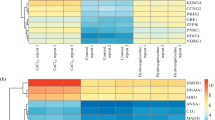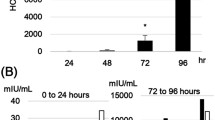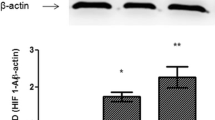Summary
During placental development, oxygen environment is not only critical for trophoblasts migration and invasion, but also fundamental for appropriate placental perfusion. Cysteine-rich 61 (Cyr61, CCN1) was expressed in the extravillous trophoblasts (EVTs) and decreased in preeclampsia. Its regulatory properties in human first-trimester extravillous trophoblast cell line (TEV-1 cells) upon a low oxygen tension were investigated. The present study examined functional changes involved in adaptation to hypoxia of the TEV-1 cells, using cobalt chloride (CoCl2) as hypoxic mimic. It was found that hypoxia inhibited growth of TEV-1 cells and induced the increase of cell apoptosis (P<0.05). The Cyr61 expression in human EVTs was transcriptionally induced by CoCl2. Inappropriate EVTs apoptosis has been implicated in the failure of trophoblasts to fully invade and modify the uterine environment and Cyr61 down-regulation, potentially leading to preeclampsia.
Similar content being viewed by others
References
Gilbert JS, Nijland MJ, Knoblich P. Placental ischemia and cardiovascular dysfunction in preeclampsia and beyond: making the connections. Expert Rev Cardiovasc Ther, 2008,6(10):1367–1377
Pringle KG, Kind KL, Sferruzzi-Perri AN, et al. Beyond oxygen: complex regulation and activity of hypoxia inducible factors in pregnancy. Hum Reprod Update, 2010,16(4):415–431
O’Brien TP, Yang GP, Sanders L, et al. Expression of cyr61, a growth factor-inducible immediate-early gene. Mol Cell Biol, 1990,10(7):3569–3577
Chen CC, Lau LF. Functions and mechanisms of action of CCN matricellular proteins. Int J Biochem Cell Biol, 2009,41(4):771–783
Gellhaus A, Schmidt M, Dunk C, et al. Decreased expression of the angiogenic regulators CYR61 (CCN1) and NOV (CCN3) in human placenta is associated with pre-eclampsia. Mol Hum Reprod, 2006,12(6):389–399
Gellhaus A, Schmidt M, Dunk C, et al. The circulating proangiogenic factors CYR61 (CCN1) and NOV (CCN3) are significantly decreased in placentae and sera of preeclamptic patients. Reprod Sci, 2007,14(Suppl 8):46–52
Wolf N, Yang W, Dunk CE, et al. Regulation of the matricellular Proteins CYR61 (CCN1) and NOV (CCN3) by hypoxia-inducible factor-1α and transforming-growth factor-β3 in the human trophoblast. Endocrinology, 2010,151(6):2835–2845
Feng HC, Choy MY, Deng W, et al. Establishment and characterization of a human first-trimester extravillous trophoblast cell line (TEV-1). J Soc Gynecol Investig, 2005,12(4):e21–32
Caniggia I, Winter J, Lye SJ, et al. Oxygen and placental development during the first trimester: implications for the pathophysiology of pre-eclampsia. Placenta, 2000,21(Suppl A):S25–30
Watson AL, Skepper JN, Jauniaux E, et al. Susceptibility of human placental syncytiotrophoblastic mitochondria to oxygen mediated damage in relation togestational age. J Clin Endocrinol Metab, 1998,83(5):1697–1705
Graeber TG, Osmanian C, Jacks T, et al. Hypoxia-mediated selection of cells with diminished apoptotic potential in solid tumours. Nature, 1996,379(6560): 88–91
Smith SC, Baker PN, Symonds EM. Placental apoptosis in normal human pregnancy. Am J Obstet Gynecol, 1997,177(1):57–65
Huppertz B, Hunt JS. Trophoblast apoptosis and placental development—a workshop report. Placenta, 2000,21(Suppl A):S74–76
Langbein M, Strick R, Strissel PL, et al. Impaired cytotrophoblast cell-cell fusion is associated with reduced Syncytin and increased apoptosis in patients with placental dysfunction. Mol Reprod Dev, 2008,75(1): 175–183
Allaire A, Ballenger K, Wells S, et al. Placental apoptosis in preeclampsia. Obstets and Gynecol, 2000,96(2): 271–276
Heazell AE, Lacey HA, Jones CJ, et al. Effects of oxygen on cell turnover and expression of regulators of apoptosis in human placental trophoblast. Placenta, 2008,29(2): 175–186
Levy R, Smith SD, Chandler K, et al. Apoptosis in human cultured trophoblasts is enhanced by hypoxia and diminished by epidermal growth factor. Am J Physiol Cell Physiol, 2000,278(5):C982–C988
Leach RE, Kilburn BA, Petkova A, et al. Diminished survival of human cytotrophoblast cells exposed to hypoxia/reoxygenation injury and associated reduction of heparin-binding EGF-like growth factor. Am J Obstet Gynecol, 2008,198(4):471.e1–8
Ishihara N, Matsuo H, Murakoshi H, et al. Increased apoptosis in the syncytiotrophoblast in human term placentas complicated by either preeclampsia or intrauterine growth retardation. Am J Obstet Gynecol, 2002,186(1): 158–166
Tomas SZ, Prusac IK, Roje D, et al. Trophoblast apoptosis in placentas from pregnancies complicated by preeclampsia. Gynecol Obstet Invest, 2011, Jan 25 (DOI: 10.1159/000320289)
DiFederico E, Genbacev O, Fisher SJ. Preeclampsia is associated with widespread apoptosis of placental cytotrophoblasts within the uterine wall. Am J Pathol, 1999,155(1):293–301
Genbacev O, DiFederico E, McMaster M, et al. Invasive cytotrophoblast apoptosis in pre-eclampsia. Hum Reprod, 1999,14(Suppl 2):59–66
Reister F, Frank HG, Kingdom JC, et al. Macrophage-induced apoptosis limits endovascular trophoblast invasion in the uterine wall of preeclamptic women. Lab Invest, 2001,81(8):1143–1152
Lau LF, Lam SCT. The CCN family of angiogenic regulators: the integrin connection. Exp Cell Res, 1999,248(1):44–57
O’Brien TP, Lau LF. Expression of the growth factor-inducible immediate early gene cyr61 correlates with chondrogenesis during mouse embryonic development. Cell Growth Diff, 1992,3(9):645–654
Mo FE, Muntean AG, Chen CC, et al. CYR61 (CCN1) is essential for placental development and vascular integrity. Mol Cell Biol, 2002,22(24):8709–8720
Yang GP, Lau LF. Cyr61, product of a growth factor-inducible immediate early gene, is associated with the extracellular matrix and the cell surface. Cell Growth Differ, 1999,2(7):351–357
Chen CC, Young JL, Monzon RI, et al. Cytotoxicity of TNF alpha is regulated by integrin-mediated matrix signaling. EMBO J, 2007,26(5):1257–1267
Juric V, Chen CC, Lau LF. Fas-mediated apoptosis is regulated by the extracellular matrix protein CCN1 (CYR61) in vitro and in vivo. Mol Cell Biol, 2009,29(12):3266–3279
Author information
Authors and Affiliations
Corresponding author
Rights and permissions
About this article
Cite this article
Chen, X., Liu, Y., Xu, X. et al. Decreased Cyr61 under hypoxia induces extravillous trophoblasts apoptosis and preeclampsia. J. Huazhong Univ. Sci. Technol. [Med. Sci.] 31, 235–240 (2011). https://doi.org/10.1007/s11596-011-0259-9
Received:
Published:
Issue Date:
DOI: https://doi.org/10.1007/s11596-011-0259-9




